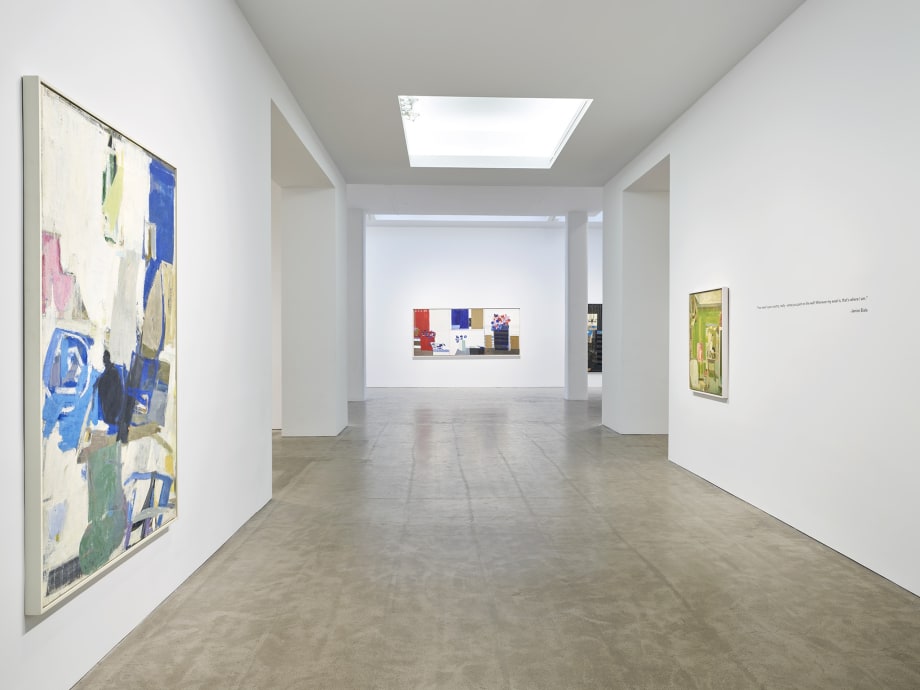This survey, featuring over 30 paintings dating from 1946 to 1986, marks the largest gallery exhibition of Biala's work mounted in New York City with many works on view for the first time. A fully illustrated 100-page catalogue accompanies the exhibition which includes introduction by Mary Gabriel, author of The Ninth Street Women, and essay by Jason Andrew, manager and curator of the Estate of Janice Biala. This historic presentation coincided with the Grey Art Museum’s seminal exhibition Americans in Paris, 1946-1962: Artists Working in Postwar France, 1946-1962, in which Biala was be featured.
One of the most inventive artists of the 20th century, and the painter most closely aligned with the continuation of a transatlantic Modernist dialogue between Paris and New York, Janice Biala (1903-2000) led a legendary life: a painter recognized for her distinctive style that combined the sublime assimilation of the School of Paris and the gestural virtuosity of the New York School of Abstract Expressionism.
Biala rose from humble yet tumultuous beginnings as a Jewish immigrant from Russian occupied Poland arriving in New York in 1913 settling among the tenements of the Lower East Side. She claimed the name of her birthplace for her own, going on to make personal and unique contributions to the rise of Modernism both in Paris and New York.
Having spent the decade of the 1930s as the last companion to the English novelist, Ford Madox Ford, Biala was the perfect representative of American bohemia in 1930s France and her journey as an artist evolved in tandem with the historic events of the 20th century.
Highlighting this survey is a pivotal group of paintings dating from 1947 to1952. On view for the first time in New York, these works were painted by Biala upon her triumphant return to Paris in 1947 aboard the de Grasse, one of the first passenger transatlantic ships to sail from New York to Europe after World War II. Her return was also a joyous one, “I still find in France all the things I’d hoped for,” she wrote her brother Jack Tworkov, “I’d have no use for Paradise if it wasn’t like France.” These works offer an extraordinary opportunity to see Biala’s close connection to European Modernists like Picasso and Matisse, both of whom she had frequently met.
“Though her themes of still life and interiors, landscapes and portraiture remained constant, her approach to portraying them evolved,” writes Jason Andrew in essay for the catalogue accompanying the exhibition:
“Impressionism is a term rarely used in discussing Biala’s work, but it fits with her sensitivity and narrative. Never liberal with factual description in her paintings, Biala pulls us in through a balance of subtle truths—the hard edge of a table, the soft outline of a figure, the dark shadow of a building. It’s a tender abstraction that feels lived in, and one which she honed very early on from her mentor Edwin Dickinson and heightened by the vigilant study of the narratives crafted by Ford Madox Ford.”
Three of the five major paintings included in the 15th annual Salon Les Surindépendants in 1948 are featured in the exhibition. Biala credited this exhibition for bringing the critical attention that would re-establish her reputation, leading to gallery representation at Galerie Jeanne Bucher and moreover praise from the staunchly critical French press.
Le Louvre, 1948, is among this group and one of the first paintings to fully capture the architecture of Biala's adopted city. A seminal work, the painting features a view of the city from the Left Bank looking North across the Seine with views of the Louvre and the Jardins des Champs-Élysées. More specifically, Pavillon de la Trémoille appears on the upper left and the various rooftops that make up the Louvre filling the horizon. Pont de Arts stretches horizontally through the painting’s center left. Framing the composition is an iron railing in the near foreground.
Alongside this historic group of paintings, Berry Campbell will present important large-scale works including multi-paneled paintings which bridge American and European traditions — portraying a synthesis of cultures and emotions. As an example, the two paneled work “Intérieur à grand plans noirs, blancs, rose,” 1972, on view for the first time, embraces Biala’s suggestive approach to space. “Here the continuity of reading the painting from left to right is deprioritized in order to offer multiple vignettes—evocative impressions and multiple views of an interior where angles are represented by juxtaposition of color,” writes Jason Andrew.
In the epic three paneled painting Les Fleurs, 1973, three differing perspectives vie for sovereignty as each offers an individually composed interior with bold and blocked in color—bare of human presence. Here the flourishing potted flowers bring the personality.
The exhibition also features a gallery dedicated to Biala’s works on paper and in particular, her collage work. As the artist noted, towards the end of the 1950s, her transatlantic returns from Paris to New York took their toll on her paintings. So, she turned her attention to collage. Embracing the “immediate effects,” which “you can’t possibly get in painting,” Biala embarked on an intense exploration of the medium. The subjects in Biala’s collages range from intimate interiors to the wild and thrilling portrayal of a cassowary.

